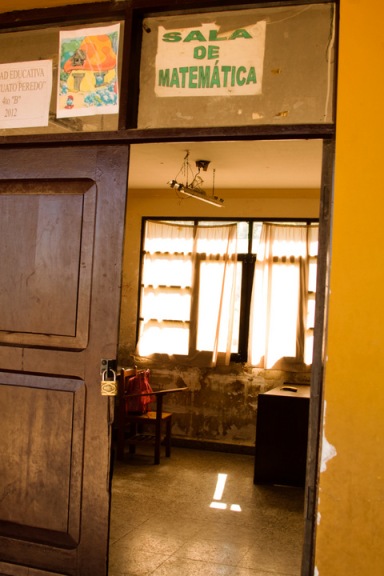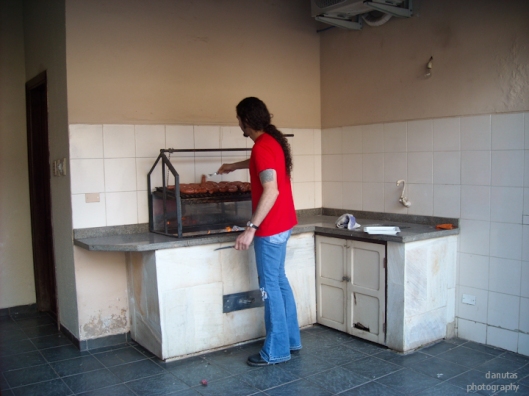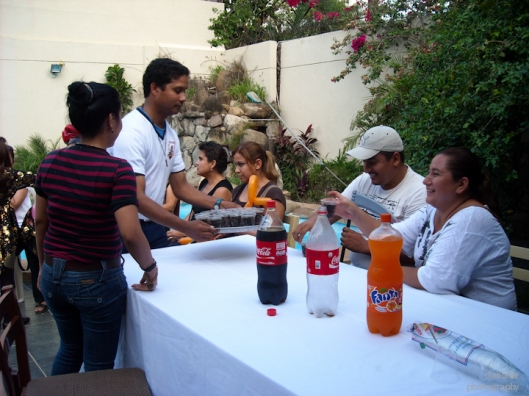Kiedy odkryto Ameryke?
Kiedy rozpoczela sie II wojna swiatowa?
Kiedy Boliwia odzyskala niepodleglosc?
Takie pytania zadalam swoim 14/15 – letnim uczniom na lekcji angielskiego, probujac praktykowac czas przeszly. Po zadaniu pytan po angielsku nie doczekalam sie odpowiedzi, po przetlumaczeniu ich na jezyk hiszpanski – rowniez nie. ‘No dobra, nie musicie podawac dokladnej daty, wystarczy stulecie’ – dodalam zrezygnowana. ‘Nie pamietacie?’ – studenci kiwaja glowami, usmiechajac sie niepewnie pod nosem. Zalamalam sie.
Innego dnia jeden z moich uczniow przyszedl na lekcje z namalowana na ramieniu swastyka. Oczywiscie wiem jakie jest pochodzenie tego pradawnego symbolu oraz jego pierwotne znaczenie, ale jako wrazliwy czlowiek (polskosc pewnie tez ma tutaj znaczenie) swiadoma jestem rowniez jego historycznych konotacji. Kiedy zapytalam ucznia, czy wie, co ten znak znaczy, odpowiedzial, ze nie. Reszta klasy tez nie miala pojecia, poza jedna uczennica, ktora skojarzyla ja z filmem ‘Pianista’, ktory akurat obejrzala w telewizji. Po krotkim ‘objasnieniu’ poprosilam studenta, ktory jest na marginesie jednym z najslodszych i niewinnych dzieciakow jakie znam, o pojscie do lazienki i zmycie swastyki z ramienia. Pewnie zostawilabym go w spokoju, gdyby powiedzial mi chociaz, ze swastyka jest symboeml solarnym, spotykanym zreszta w kulturach przedkolumbijskich, ale dla ignorancji i bezmyslnego powielania zachowan nie mam cierpliwosci.
Pamietam ze swojej szkoly podstawowej sytuacje, kiedy jeden z kolegow przyszedl na lekcje z ‘wasami Hitlera’ – smiechu bylo co nie miara (uczen ten byl naszym ‘klasowym klaunem’), ale nauczyciel o mal nie dostal zawalu. Po incydencie szkola zorganizowala specjaly apel, a nauczyciele rozmawiali ze wszystkimi uczniami o niestosownosci tego zachowania. Przesada? Moze i tak, ale przynajmniej nikt nie zostal obojetny na to co sie stalo. Zreszta, pamietacie jaki skandal wywolal ksiaze Harry przebierajac sie za oficera SS?
Dla Ameryki Poludniowej historia Europy wydaje sie byc opowiescia o dalekich ladach, zreszta tak jak dla nas historia Inkow czy Majow. Niedawno, na coniedzielnym bazarku rekodziela artystycznego w Santa Cruz odbywajacym sie w cieniu katedry, wypatrzylam ozdoby zywo przypomnajace swastyki III Rzeszy… Nie chcialo mi sie wypytywac sprzedawczyni o znaczenie tego symbolu – ale nastepnym razem nie odpuszcze. Alez sie uwzielam na te swastyke!
Czym wiec mozna wytlumaczyc niewiedze studentow o najwazniejszych wydarzeniach w historii swiata i Boliwii? Oto jest pytanie!
W Boliwii dzialaja zarowno szkoly prywatne jak i panstwowe. Nie musze dodawac, ze te pierwsze znaczaco roznia sie od drugich – sama mialam okazje odwiedzic ‘amerykanski’ Calvert oraz mala szkole podstawowa na przedmiesciach Cochabamby – kontrast jest przerazajacy. Zreszta, moja ostatnia ( i jednoczesnie pierwsza) wizyta w glownej bibliotece publicznej w Santa Cruz (1,5 mln mieszkancow) pokazala, ze osrodki panstwowe cierpia niesamowicie na brak wsparcia finansowego – ksiazek tam bylo mniej niz w naszej poczciwej Bibliotece Gminnej w Sadlinkach (1,7 tys. mieszkancow).
Moi studenci pochodza z domow raczej zamoznych, uczeszczaja do tych lepszych szkol publicznych, ale mimo iz szpanuja najnowszymi smartfonami i nosza koszulki za 30 $, w glowach raczej za wiele nie maja… Probowalam dopytac sie pracujacych ze mna pedagogow, jaka jest tego przyczyna – wszyscy zgodnie odpowiedzieli, ze szkolom brakuje dobrych podrecznikow a ilosc uczniow w klasie przekracza 40! Prawde mowiac, nie zazdroszcze moim kolegom pracy ani uczniom nauki w takich warunkach.
Ale oczywiscie szkola szkole nierowna, uczen uczniowi rowniez – jeden wie wiecej inny mniej. Takimi ‘wyjatkami od reguly’ sa moi znajomi studenci z Cochabamby, ktorzy mimo przejscia przez te ‘szkoly – fabryki’ zdobyli wysokie wyksztalcenie i to nie tylko na papierku. Jako studenci lingwistyki, wladaja co najmniej dwoma jezykami obcymi i maja szerokie zainteresowania. To samo moge powiedziec o innych studentach panstwowego uniwersytetu, ktorych spotkalam na swojej drodze. A nie jest im latwo – biblioteka uniwersytecka nie posiada tysiecy ksiazek w kilku egzemplarzach, wydziay nie sa skomputeryzowane i czasem jedyna skarbnica wiedzy okazuje sie skserowany podrecznik oraz dobry nauczyciel. Jak widac, dla chcacego nie ma jednak nic trudnego i czasem to wystarczy:)
Wnioski?
Coz, ‘Ameryki nie odkrylam’ – najwazniejsza przyczyna niewiedzy jest przewaznie ignorancja oraz lenistwo. Ten kto jest ciekawy swiata, zawsze znajdzie droge, by go poznac.
A ja na razie planuje dla swoich uczniow pokaz ‘Pianisty’ lub ‘Listy Schindlera’ oraz quiz historyczny z zastoswaniem czasu Past Simple – czas moze prosty i latwy, ale historia niestety jest troche bardziej skomplikowana i czasem ciezka do strawienia.
Zarowno jezyk jak i historia sa tak samo niezbedne do wzajemnego zrozumienia oraz klarownej komunikacji ze swiatem.
***
When was America discovered ?
When did World War II start/end?
When did Bolivia gain its independence?
I asked these questions to my 14-15 year old students during English class, trying to practice the past tense. After asking questions in English I didn’t get any answer, neither did I after translating them into Spanish. ‘Okay, You don’t have to give me the exact date, just a century’ – I added. Nothing?’ – students nodded their heads smiling. I resigned.
The other day one of my students came to class with a swastika painted on his shoulder. Of course I know what is the origin of this ancient symbol and its true meaning, but as a sensitive person (and Polish) I am also aware of its historical connotations. When I asked the student if he knew what the sign means, he did not. The rest of the class also had no idea, except for one student, who saw the movie ‘The Pianist’ showing in TV the night before. After a short ‘explanation’ I asked the student, who is by the was one of the sweetest and innocent kids that I know, to go to the bathroom and wash it off. Probably I would have left him alone, if only he told me that swastika is a (among others) solar symbol, also common in pre-Columbian cultures, but I can’t stand the ignorance and mindless mimicking.
I remember a situation from my elementary school (long time ago), when one friend came to class with ‘Hitler’s mustache’ – the class was laughting out loud (he was our ‘class clown’), but the teacher almost got heart attack. After the incident, school principal organized special appeal and the teachers were talking to all students about the impropriety of this behavior. Exaggeration? Maybe so, but at least no one was indifferent to what happened. Well, do you remember the scandal with Prince Harry dressing up as an SS officer? We Europeans are quite sensitive in that matter.
For South America however, European history seems to be a story of far-off lands – as for us Inca and Mayan history. Recently, on the Sunday handicrafts market in Santa Cruz, held in the shadow of the cathedral, I spotted neclaces resembling swastika of the Third Reich … I didn’t ask the seller if she knew the meaning of the symbol – but next time I will, just to check.
So, how can students ignorance about the most important events in the history of the world and Bolivia be explained? That is the question!
In Bolivia, there are both private schools and state collegios. Needless to say, the first are significantly different from the latter – I had a chance to visit the ‘American’ Calvert and a small elementary school on the outskirts of Cochabamba – and the contrast was frightening. Moreover, my last (and first in the same time) visit in the main public library in Santa Cruz (city of 1.5 million inhabitants) has shown that in public institutions suffer incredible from the lack of financial support – there was less books than in my old library in Sadlinki (1,7 thousand inhabitants).
All my students come from more affluent homes, they attend better public school, but although having latest smartphones and wearing T-shirts for $ 30, there isn’t muchin their heads… I tried to find out reasons of this situation asking my fellow teachers – all responded the same that schools lack good handbooks and often number of students in the class exceeds 40! I don’t envy my students to study or teachers to work in such conditions.
But of course, one school differs from other and students are not the same – one knows more other less. Such “exceptions’ are my friends, students from Cochabamba, who despite of going through these’ schools – factories’, gained the high level of education – not only on the paper. As students of linguistics, they speak at least two foreign languages and have broad interests. The same I can say about the other students of the State University that I met on my way. And it wasn’t easy for them – not the university has a library with thousands of books in several copies, nor the Faculties are computerized and sometimes the only source of knowledge turns out to be photocopied handbook and a good teacher. As you can see, nothing is impossible to a willing mind and sometimes that’s enough :)
Conclusions?
Well, ‘I didn’t discover America’ – the most important cause of lack of knowledge is ignorance and laziness. Anyone who is curious about the world, always finds a way to learn.
And as for me, I make plans to show movies such as ‘The Pianist’ or ‘Schindler’s List’ to my students and prepare history quiz using Past Simple – the tense may be simple and easy, but unfortunately the history is a little more complicated and sometimes heavy to digest.
Both the language and history, however, are just as necessary for mutual understanding and clear communication with the world.










